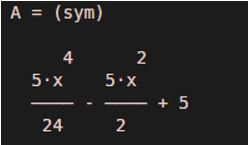Updated March 13, 2023
Introduction to Taylor Series Matlab
The following article provides an outline for Taylor Series Matlab. Taylor series is used to expand a function into an infinite sum of terms. Taylor series expresses the function in terms of its derivative at a point.
Example:
Taylor series of e^x = 1 + x + x^2/2! + x^3/3! + x^4/4! + x^5/5! + …
As can see in the above example, we have drilled down the function ‘e^x’ into a polynomial which is of infinite degree. It finds its application in modern day Physics to simplify complex calculations, by breaking them down into the simple sum of terms. In Matlab, we use the ‘taylor’ function to get taylor series of any function.
Syntax:
A = taylor (Fx, p)
A = taylor (Fx, p, a)
A = taylor (Fx, Name, Value)
Explanation:
- taylor (Fx, p) will compute the Taylor series for the input function. By default, the series is computed till the 5th order and at ‘p = 0’ as the point.
- taylor (Fx, p, a) will compute the Taylor series for input function at the point p = a.
- taylor (Fx, Name, Value) can be used to put additional conditions, which can be specified using pair arguments (Name, Value).
Examples of Taylor Series Matlab
Let us now see the code to calculate in Matlab using ‘taylor (Fx, p) function’:
Example #1
In this example, we will use a simple cos function and will expand it using Taylor series function.
We will follow the following 2 steps:
- Create the cos function in Matlab.
- Calculate the Taylor series using ‘Taylor function’.
Syntax:
syms x
[Initializing the variable ‘x’]
A = taylor (5* cos (x))
Code:
syms x
A = taylor (5* cos (x))
Output:
Let us now see how the code for Taylor series looks like in Matlab if we want to use the point of our choice for Taylor series. For this purpose, we will be using ‘taylor (Fx, p, a)’ function and will pass some value for ‘p’.
Example #2
In this example, we will use a function of sine and will find the Taylor series at the point p = 1.
We will follow the following 2 steps:
- Create the function of sine in Matlab.
- Calculate the Taylor series using ‘taylor (Fx, p, a) function’ and pass ‘p’ as 1.
Syntax:
syms x
[Initializing the variable ‘x’]
A = taylor(4*sin(x)) x, 1)
Code:
syms x
A = taylor(4*sin(x), x, 1)
Output:
Let us now see how the code for Taylor series looks like if we need to add more conditions using the ‘Name’, ‘Value’ pair arguments. For this purpose, we use ‘taylor (Fx, Name, Value)’ function.
Example #3
In this example, we will use the same polynomial function as used in the above example but will find the Taylor series only till 2nd order.
We will follow the following 2 steps:
- Create the function of cos and sine.
- Calculate the Taylor series using the function ‘taylor (Fx, Name, Value)’.
Syntax:
syms x
[Initializing the variable ‘x’]
A = taylor ((5*cos (x) + 4*sin (x)), x, 1, 'Order', 2)
Code:
syms x
A = taylor ((5*cos (x) + 4*sin (x)), x, 1, 'Order', 2)
Output:
Conclusion
A function’s Taylor series can be found in Matlab using taylor function. By default, the Taylor series is computed at point x = 0. If we need Taylor series w.r.t some other point, we can use taylor (Fx, p, a).
Recommended Articles
This is a guide to Taylor Series Matlab. Here we discuss the introduction to Taylor Series Matlab along with examples respectively. You may also have a look at the following articles to learn more –





